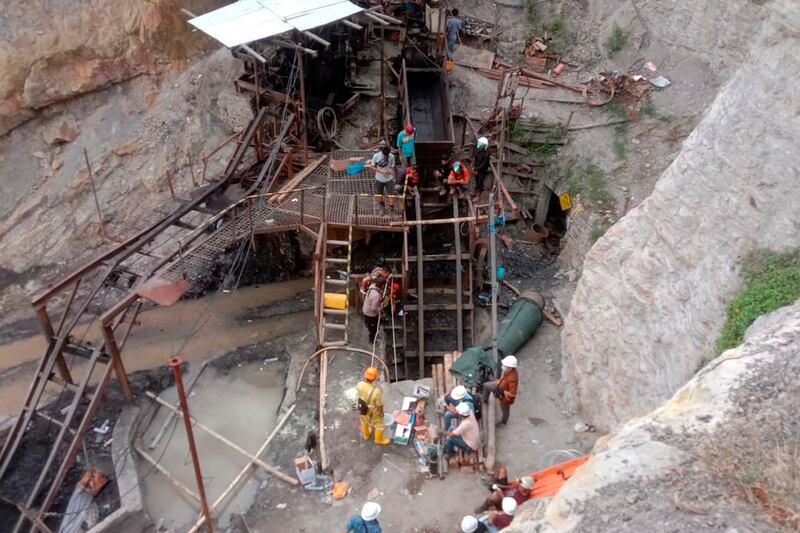Methane emissions from Indonesia’s coal mines are significantly underreported, potentially undermining its international pledges on climate change, according to a report released Tuesday.
The findings by Ember, a London think-tank, suggest that emissions from coal mine methane (CMM) in Indonesia are nearly seven times underreported because Southeast Asia’s largest country uses outmoded measurement methods and excludes emissions from underground mines.
“The use of outdated methane estimation methods risks undermining the scale of Indonesia’s coal mine methane problem,” said Dody Setiawan, Ember’s senior Indonesia climate and energy analyst.
"Consequently, Indonesia could jeopardize its international standing as it is committed to slashing methane globally," he said in the report.
Independent analyses of satellite and mine-level data indicate CMM emissions ranging up to 875 kilotons, significantly higher than the official Indonesian figure of 128 kilotons in 2019, the report said.
“Official estimates have overlooked CMM emissions from several underground mines,” Ember reported, adding that such methane leaks are seriously hazardous because of explosion risks.
Indonesia has 15 companies involved in underground coal mining, the study said, although in 2021 it reported to the United Nations Framework Convention on Climate that it had none. The convention is a multilateral treaty adopted in 1992 to stabilize greenhouse gases.
BenarNews contacted Dadan Kusdiana, the secretary-general at the Indonesian Ministry of Energy and Mineral Resources, to seek the government’s response to the report.
“I need to study the report first,” Kusdiana said.
Other officials at the ministry could not be immediately reached for comment.
This underreporting could cast Indonesia in a negative light on international climate efforts, because the country is a signatory to the Global Methane Pledge, which aims to reduce methane emissions by 30% from 2020 levels by 2030, the report said.
Indonesia is the world's largest thermal coal exporter by volume, and the third largest coal producing country after China and India. Thermal coal is used to produce electricity, while coking coal is an ingredient in iron and steel production.
The country’s Ministry of Energy and Mineral Resources reported a 13% increase in coal production in 2023 from the previous year, reaching an all-time high.
Methane, the second-highest contributor to climate change after carbon dioxide, is a potent greenhouse gas with more than 80 times the warming power of carbon dioxide over a 20-year period.
Considering all adjustments for measurements and the expected increase in coal production, Indonesia’s future coal mine methane emissions could escalate to approximately 1,007 kilotons annually, the Ember report said.
This amount is 30 million tons of CO2 equivalent, surpassing the emissions from forest and land fires over 200,000 hectares in 2022, it said.

Dorothy Mei, project manager at Global Energy Monitor (GEM), said Indonesia’s active participation in methane reduction was essential to reduce global emissions.
“Indonesia must plan to monitor its emissions and improve the accessibility of its coal mining and methane data, to help fully achieve the goals of the Global Methane Pledge,” she said in the report.
However, Indonesia is not alone in underreporting CMM emissions, according to a November report by Ember. Citing independent studies, it warned that such emissions could be more than twice as high as reported by governments.
“Many countries don’t report [CMM emissions] regularly, and some have never reported CMM,” Ember’s November report said.
“Independent studies have found that 22 countries could be emitting double the emissions they currently report, including South Africa, Germany and Indonesia.”
For instance, the International Energy Agency’s 2023 Methane Tracker estimated that Australia had underreported its CMM by 82% in 2022.
Indonesia’s coal reserves, primarily consist of lower-quality lignite and subbituminous coal, span across seven major coal basins including in Central and South Sumatra and Kalimantan.
Higher-quality coals are found in the Barito basin and the Ombilin Basin in West Sumatra.
Different coal types, ranging from high-energy anthracite to the lowest-energy lignite, emit different levels of methane during extraction.
Higher-ranked coals emit more methane and lower-ranked coals, like those predominantly mined in Indonesia, release less methane.
Despite primarily using surface mining methods, Indonesia has reported a rapid increase in coal-mine methane emissions, growing by an average of 12% annually since 2000, the report said.
This trend positions coal mine methane as the fastest-growing source of emissions within the energy sector, set to become the major methane emitter, it said.
Yayan Satyakti, an economist at Padjadjaran University in Bandung, said methane was more challenging to measure without accurate methods.
“However, high-frequency satellite technology, like that of NASA, has made measurement possible and relatively accurate, although national-level analysis can be debatable due to less detailed satellite database parcels if not calibrated with national data,” he said.
Yayan expressed concern over the accuracy of environmental indicators released by the government, citing issues with sampling and monitoring systems.
He also highlighted the uncertainty surrounding Indonesia's Nationally Determined Contributions (NDC) targets and environmental policies, which are gradually shifting due to investment interests, potentially reducing the country's commitment to sustainable development.
